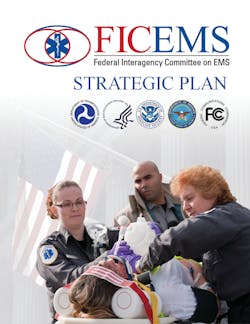Federal Agencies Coordinate to Advance EMS
In an effort to further coordinate federal efforts in emergency medical services (EMS), the members of the Federal Interagency Committee on EMS (FICEMS) reached consensus on a strategic plan that maps action steps for federal support of optimal EMS systems nationwide.
FICEMS members recently approved and released the five-year plan, which was developed through a collaborative process and funded by three different departments.
FICEMS vision statement: A federal interagency committee that enhances coordination and ensures the strategic alignment of EMS priorities among Federal agencies to ensure quality patient care
FICEMS mission statement: Ensure coordination among Federal agencies, supporting local, regional, state, tribal and territorial emergency medical services and 9-1-1 systems, to improve the delivery of EMS services throughout the nation.
“The mission and vision statements clarify the role of FICEMS and our intention to support the needs and efforts of the EMS professionals across the nation who deliver care to their communities daily,” said Dr. Kathryn Brinsfield, Acting Assistant Secretary for Health Affairs and Chief Medical Officer of the Department of Homeland Security, and incoming FICEMS chair.
To download the FICEMS Strategic Plan, visit www.ems.gov/ficems/plan.htm.
Oregon Tech and OHSU Launch Bachelor’s Degree in EMS Management
The educational partnership between Oregon Institute of Technology (Oregon Tech) and Oregon Health Sciences University (OHSU) has launched a Bachelor of Science degree in Emergency Medical Services (EMS) Management. This new bachelor’s degree, one of only 13 in the United States and the only program of its kind in Oregon, will provide a direct educational pathway for both current and aspiring pre-hospital providers to obtain the education and training necessary take leadership position in Emergency Medical Services.
“We are excited to utilize the resources of both great institutions in preparing graduates to enter the workforce with the skills and background necessary to become clinical and organizational leaders in the EMS industry,” said Program Director Jamie Kennel. “We are also very proud to do our part in further professionalizing the EMS industry.”
The new Bachelor’s degree of EMS Management is comprised of training in three core areas:
- Advanced clinical education in either pre-hospital Critical Care Medicine or Community Care Paramedicine;
- Foundational training in general management principles;
- Specific management training focused on the challenges and opportunities unique to the EMS industry.
The new program is designed to work with EMS professionals who are working full time in the field through a combination of both night classes as well as the flexibility to enroll in a mix of online or face-to-face classes.
For more information please visit www.oit.edu/wilsonville/academics/degrees/ems.
USFA Releases New Emergency Vehicle Safety Initiative
Approximately 25 percent of on-duty firefighter fatalities occur each year while responding to or returning from incidents, with the majority of fatalities resulting from vehicle crashes. Vehicle collision is the second leading cause of firefighter fatalities.
The U.S. Fire Administration (USFA) is committed to reducing firefighter fatalities and injuries by helping to create a safer operational environment for emergency responders. The resources below contain best practices and recommendations for safer emergency vehicle and roadway incident response.
Since the release of its publication “Emergency Vehicle Safety Initiative (2004),” the USFA has worked with many fire service organizations and the law enforcement community to increase emergency responder safety in this area. Its latest report, “Emergency Vehicle Safety Initiative (2014),” consolidates the results of this work and provides best practices and recommendations for safer emergency vehicle and roadway incident response.
Topics covered include:
- Common crash causes and crash prevention.
- The impact of vehicle design and maintenance on safety.
- Internal and external factors for improving response-related safety.
- Regulating emergency vehicle response and roadway scene safety.
- Roadway incident scene safety.
For more information, visit www.usfa.fema.gov/fireservice/firefighter_health_safety/safety/vehicle_safety/.






